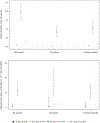Incidence of suicide and self-harm among people with opioid use disorder and the impact of opioid agonist treatment: A retrospective data linkage study
- PMID: 37028102
- PMCID: PMC10225170
- DOI: 10.1016/j.drugalcdep.2023.109851
Incidence of suicide and self-harm among people with opioid use disorder and the impact of opioid agonist treatment: A retrospective data linkage study
Abstract
Background: Rates of suicide and self-harm are elevated among people with opioid use disorder (OUD). This study examined incidence of self-harm and suicide among people who have entered OAT and assessed the impact of different OAT exposure periods on these events.
Method: We conducted a retrospective population-based cohort study of all OAT recipients (N = 45,664) in New South Wales, Australia (2002-2017), using linked administrative data. Incidence rates of self-harm hospitalisations and suicide deaths were estimated per 1000 person-years (PY). The first 28 days of an OAT episode, ≥ 29 days on OAT, the first 28 days off OAT, and ≥ 29 days off OAT (maximum four years post-OAT) were exposure periods. Poisson regression models with generalised estimating equations estimated the adjusted incidence rate ratios (ARR) of self-harm and suicide by OAT exposure periods, adjusting for covariates.
Results: There were 7482 hospitalisations (4148 individuals) for self-harm and 556 suicides, equating to incidence rates of 19.2 (95% confidence intervals [CI]=18.8-19.7) and 1.0 (95%CI=0.9-1.1) per 1000 PY, respectively. Opioid overdose was implicated in 9.6% of suicides and 28% of self-harm hospitalisations. Compared to ≥ 29 days on OAT, the incidence rate of suicide was elevated in the 28 days following OAT cessation (ARR=17.4 [95%CI=11.7-25.9]), and the rate of self-harm hospitalisations was elevated during the first 28 days of OAT (ARR=2.2 [95%CI=1.9-2.6]) and the 28 days after leaving OAT (ARR=2.7 [95%CI=2.3-3.2]).
Conclusions: OAT may reduce suicide and self-harm risk among people with OUD; however, OAT initiation and cessation are critical periods for targeting self-harm and suicide prevention interventions.
Keywords: Opioid agonist treatment; Opioid use disorder; Self-harm; Suicide.
Copyright © 2023 Elsevier B.V. All rights reserved.
Conflict of interest statement
Conflict of interest In the past three years, LD and MF have received investigator-initiated untied educational grants for studies of opioid medications in Australia from Indivior and Seqirus. All other authors have no conflicts of interest to declare.
Figures
Similar articles
-
Self-harm and suicide during and after opioid agonist treatment among primary care patients in England: a cohort study.Lancet Psychiatry. 2022 Feb;9(2):151-159. doi: 10.1016/S2215-0366(21)00392-8. Epub 2021 Dec 15. Lancet Psychiatry. 2022. PMID: 34921800
-
The impact of opioid agonist treatment on hospitalisations for injecting-related diseases among an opioid dependent population: A retrospective data linkage study.Drug Alcohol Depend. 2022 Jul 1;236:109494. doi: 10.1016/j.drugalcdep.2022.109494. Epub 2022 May 13. Drug Alcohol Depend. 2022. PMID: 35605532
-
Reductions in emergency department presentations associated with opioid agonist treatment vary by geographic location: A retrospective study in New South Wales, Australia.Drug Alcohol Rev. 2019 Sep;38(6):690-698. doi: 10.1111/dar.12976. Drug Alcohol Rev. 2019. PMID: 31577058 Free PMC article.
-
Hepatitis C reinfection after successful antiviral treatment among people who inject drugs: A meta-analysis.J Hepatol. 2020 Apr;72(4):643-657. doi: 10.1016/j.jhep.2019.11.012. Epub 2019 Nov 27. J Hepatol. 2020. PMID: 31785345
-
Association of Opioid Agonist Treatment With All-Cause Mortality and Specific Causes of Death Among People With Opioid Dependence: A Systematic Review and Meta-analysis.JAMA Psychiatry. 2021 Sep 1;78(9):979-993. doi: 10.1001/jamapsychiatry.2021.0976. JAMA Psychiatry. 2021. PMID: 34076676 Free PMC article.
Cited by
-
Suicide in people prescribed opioid-agonist therapy in Scotland, United Kingdom, 2011-2020: A national retrospective cohort study.Addiction. 2025 Feb;120(2):276-284. doi: 10.1111/add.16680. Epub 2024 Oct 22. Addiction. 2025. PMID: 39438020 Free PMC article.
-
Quantifying the impact of a large-scale opioid agonist treatment program on suicide prevention in New South Wales, Australia: A data-modeling study.Addiction. 2025 Aug;120(8):1601-1609. doi: 10.1111/add.70018. Epub 2025 Feb 25. Addiction. 2025. PMID: 40000421 Free PMC article.
-
Data Resource Profile Update: The Opioid Agonist Treatment and Safety II (OATS II) Study, 2001-22, New South Wales, Australia.Int J Epidemiol. 2025 Feb 16;54(2):dyaf037. doi: 10.1093/ije/dyaf037. Int J Epidemiol. 2025. PMID: 40187894 Free PMC article. No abstract available.
-
Suicide within 1 year of non-fatal overdose: Risk factors and risk reduction with medications for opioid use disorder.Gen Hosp Psychiatry. 2024 Jan-Feb;86:24-32. doi: 10.1016/j.genhosppsych.2023.11.003. Epub 2023 Nov 4. Gen Hosp Psychiatry. 2024. PMID: 38061284 Free PMC article.
References
-
- World Health Organization (WHO). Suicide worldwide in 2019: global health estimates. Geneva: World Health Organization, 2021.
-
- Knipe D, Padmanathan P, Newton-Howes G, Chan LF, Kapur N. Suicide and self-harm. The Lancet 2022; 399(10338): 1903–16. - PubMed
-
- World Health Organization (WHO). Comprehensive mental health action plan 2013–2030. Geneva: World Health Organization, 2021.
Publication types
MeSH terms
Substances
Grants and funding
LinkOut - more resources
Full Text Sources
Medical



